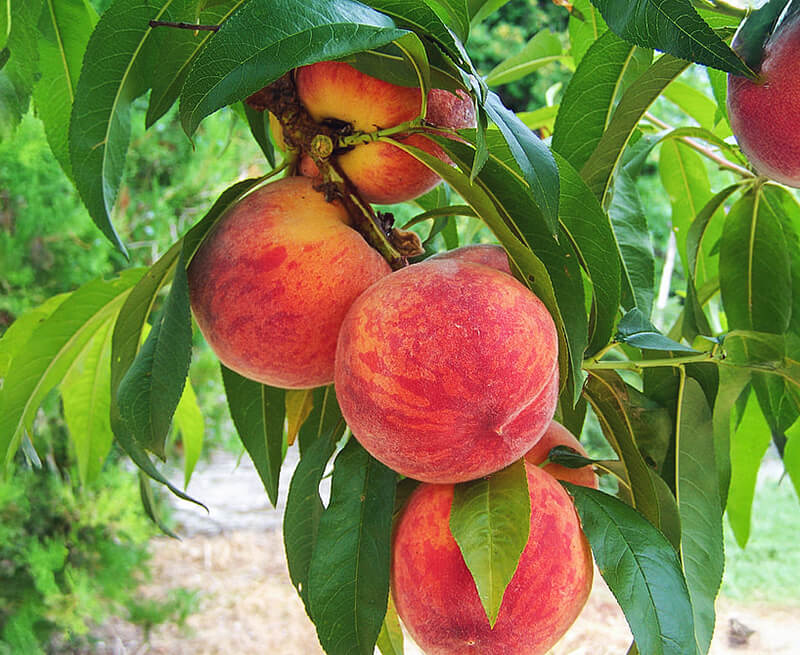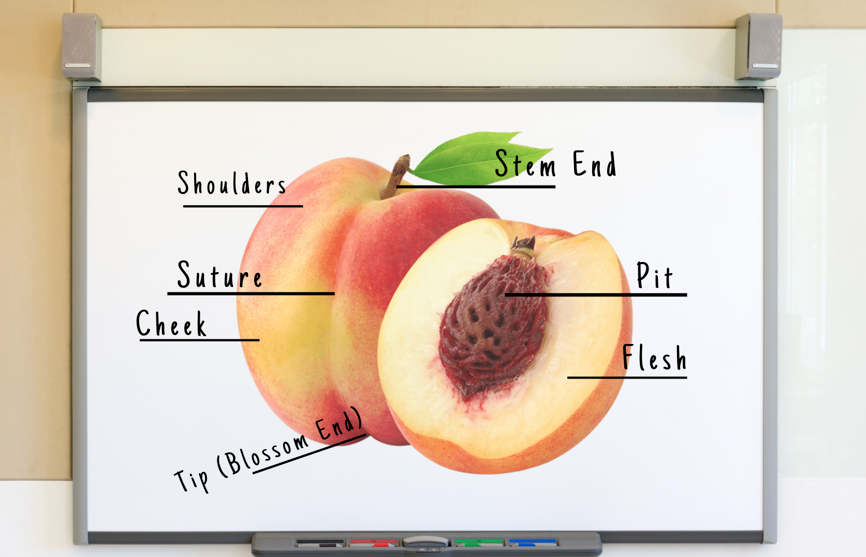Peaches: What's All the Fuzz About?
Students explore peach production in various regions of the United States, describe how peaches are produced and processed from farm to table, and explain how internal and external structures of peaches support survival and growth.

Background
Lesson Activities
Recommended Companion Resources
Credits
Author
Bekka Israelsen | Utah Agriculture in the Classroom
Sources
- https://www.farmflavor.com/lifestyle/how-peaches-are-harvested-and-other-peach-fun-facts/#:~:text=Peaches%20are%20packed%20with%20several,sugar%20and%20naturally%20fat%20free
- https://www.britannica.com/plant/peach
- https://fruitguys.com/2013/08/ten-tasty-facts-you-probably-didnt-know-about-the-peach/
Standards
Texas Content Area Standards
-
ELA: 4.110.6.b.1
Developing and sustaining foundational language skills: listening, speaking, discussion, and thinking- oral language. The students develops oral language through listening, speaking, and discussion.
- ELA: 4.110.6.b.1.D: work collaboratively with others to develop a plan of shared responsibilities
-
Social Studies: 3.113.14.c.14
Social studies skills. The student applies critical-thinking skills to organize and use information acquired from a variety of valid sources, including technology. The student is expected to:
- Social Studies: 3.113.14.c.14.C: interpret oral, visual, and print material by sequencing, categorizing, identifying the main idea, distinguishing between fact and opinion, identifying cause and effect, comparing, and contrasting
-
Social Studies: 3.113.14.c.15
Social studies skills. The student communicates in written, oral, and visual forms. The student is expected to:
- Social Studies: 3.113.14.c.15.D: express ideas orally based on knowledge and experiences
-
Social Studies: 4.113.15.c.19
Social studies skills. The student applies critical-thinking skills to organize and use information acquired from a variety of valid sources, including technology. The student is expected to:
- Social Studies: 4.113.15.c.19.C: analyze information by applying absolute and relative chronology through sequencing, categorizing, identifying cause-and-effect relationships, comparing, contrasting, finding the main idea, summarizing, making generalizations and predictions, and drawing inferences and conclusions;
-
Social Studies: 4.113.15.c.21
Social studies skills. The student communicates in written, oral, and visual forms. The student is expected to:
- Social Studies: 4.113.15.c.21.C: express ideas orally based on research and experiences
-
Social Studies: 5.113.16.c.23
Social studies skills. The student applies critical-thinking skills to organize and use information acquired from a variety of valid sources, including technology. The student is expected to:
- Social Studies: 5.113.16.c.23.C: analyze information by applying absolute and relative chronology through sequencing, categorizing, identifying cause-and-effect relationships, comparing, contrasting, finding the main idea, summarizing, making generalizations and predictions, and drawing inferences and conclusions
-
Social Studies: 5.113.16.c.25
Social studies skills. The student communicates in written, oral, and visual forms. The student is expected to:
- Social Studies: 5.113.16.c.25.C: express ideas orally based on research and experiences
-
Science: 3.112.5.b.1
Scientific and engineering practices. The student asks questions, identifies problems, and plans and safely conducts classroom, laboratory, and field investigations to answer questions, explain phenomena, or design solutions using appropriate tools and models. The student is expected to:
- Science: 3.112.5.b.1.A: ask questions and define problems based on observations or information from text, phenomena, models, or investigations
- Science: 3.112.5.b.1.F: construct appropriate graphic organizers to collect data, including tables, bar graphs, line graphs, tree maps, concept maps, Venn diagrams, flow charts or sequence maps, and input-output tables that show cause and effect
-
Science: 3.112.5.b.5
Recurring themes and concepts. The student understands that recurring themes and concepts provide a framework for making connections across disciplines. The student is expected to:
- Science: 3.112.5.b.5.F: explain the relationship between the structure and function of objects, organisms, and systems
- Science: 3.112.5.b.5.G: explain how factors or conditions impact stability and change in objects, organisms, and systems
-
Science: 3.112.5.b.11
Earth and space. The student understands how natural resources are important and can be managed. The student is expected to:
- Science: 3.112.5.b.11.B: explain why the conservation of natural resources is important
-
Science: 3.112.5.b.12
Organisms and environments. The student describes patterns, cycles, systems, and relationships within environments. The student is expected to:
- Science: 3.112.5.b.12.A: explain how temperature and precipitation affect animal growth and behavior through migration and hibernation and plant responses through dormancy
-
Science: 4.112.6.b.1
Scientific and engineering practices. The student asks questions, identifies problems, and plans and safely conducts classroom, laboratory, and field investigations to answer questions, explain phenomena, or design solutions using appropriate tools and models. The student is expected to:
- Science: 4.112.6.b.1.A: ask questions and define problems based on observations or information from text, phenomena, models, or investigations
- Science: 4.112.6.b.1.F: construct appropriate graphic organizers to collect data, including tables, bar graphs, line graphs, tree maps, concept maps, Venn diagrams, flow charts or sequence maps, and input-output tables that show cause and effect
-
Science: 4.112.6.b.5
Recurring themes and concepts. The student understands that recurring themes and concepts provide a framework for making connections across disciplines. The student is expected to:
- Science: 4.112.6.b.5.F: explain the relationship between the structure and function of objects, organisms, and systems
- Science: 4.112.6.b.5.G: explain how factors or conditions impact stability and change in objects, organisms, and systems
-
Science: 4.112.6.b.11
Earth and space. The student understands how natural resources are important and can be managed. The student is expected to:
- Science: 4.112.6.b.11.A: identify and explain advantages and disadvantages of using Earth's renewable and nonrenewable natural resources such as wind, water, sunlight, plants, animals, coal, oil, and natural gas
- Science: 4.112.6.b.11.B: explain the critical role of energy resources and how conservation, disposal, and recycling of natural resources impact the environment and modern life
-
Science: 4.112.6.b.13
Organisms and environments. The student knows that organisms undergo similar life processes and have structures that function to help them survive within their environments. The student is expected to:
- Science: 4.112.6.b.13.A: explore and explain how structures and functions of plants such as waxy leaves and deep roots enable them to survive in their environment
-
Science: 5.112.7.b.1
Scientific and engineering practices. The student asks questions, identifies problems, and plans and safely conducts classroom, laboratory, and field investigations to answer questions, explain phenomena, or design solutions using appropriate tools and models. The student is expected to:
- Science: 5.112.7.b.1.A: ask questions and define problems based on observations or information from text, phenomena, models, or investigations
- Science: 5.112.7.b.1.F: construct appropriate graphic organizers used to collect data, including tables, bar graphs, line graphs, tree maps, concept maps, Venn diagrams, flow charts or sequence maps, and input-output tables that show cause and effect
-
Science: 5.112.7.b.5
Recurring themes and concepts. The student understands that recurring themes and concepts provide a framework for making connections across disciplines. The student is expected to:
- Science: 5.112.7.b.5.F: explain the relationship between the structure and function of objects, organisms, and systems
- Science: 5.112.7.b.5.G: explain how factors or conditions impact stability and change in objects, organisms, and systems
-
Science: 5.112.7.b.11
Earth and space. The student understands how natural resources are important and can be managed. The student is expected to design and explain solutions such as conservation, recycling, or proper disposal to minimize environmental impact of the use of natural resources.
- Science: 5.112.7.b.11: Earth and space. The student understands how natural resources are important and can be managed. The student is expected to design and explain solutions such as conservation, recycling, or proper disposal to minimize environmental impact of the use of natural resources.
-
Science: 5.112.7.b.12
Organisms and environments. The student describes patterns, cycles, systems, and relationships within environments. The student is expected to:
- Science: 5.112.7.b.12.A: observe and describe how a variety of organisms survive by interacting with biotic and abiotic factors in a healthy ecosystem
- Science: 5.112.7.b.12.C: describe a healthy ecosystem and how human activities can be beneficial or harmful to an ecosystem
-
Science: 5.112.7.b.13
Organisms and environments. The student knows that organisms undergo similar life processes and have structures and behaviors that help them survive within their environments. The student is expected to:
- Science: 5.112.7.b.13.A: analyze the structures and functions of different species to identify how organisms survive in the same environment
-
ELA: 3.110.5.b.1
Developing and sustaining foundational language skills: listening, speaking, discussion, and thinking--oral language. The student develops oral language through listening, speaking, and discussion. The student is expected to:
- ELA: 3.110.5.b.1.C: speak coherently about the topic under discussion, employing eye contact, speaking rate, volume, enunciation, and the conventions of language to communicate ideas effectively
- ELA: 3.110.5.b.1.D: work collaboratively with others by following agreed-upon rules, norms, and protocols
-
ELA: 3.110.5.b.6
Comprehension skills: listening, speaking, reading, writing, and thinking using multiple texts. The student uses metacognitive skills to both develop and deepen comprehension of increasingly complex texts. The student is expected to:
- ELA: 3.110.5.b.6.G: evaluate details read to determine key ideas
-
ELA: 3.110.5.b.7
Response skills: listening, speaking, reading, writing, and thinking using multiple texts. The student responds to an increasingly challenging variety of sources that are read, heard, or viewed. The student is expected to:
- ELA: 3.110.5.b.7.F: respond using newly acquired vocabulary as appropriate
-
ELA: 4.110.6.b.6
Comprehension skills: listening, speaking, reading, writing, and thinking using multiple texts. The student uses metacognitive skills to both develop and deepen comprehension of increasingly complex texts. The student is expected to:
- ELA: 4.110.6.b.6.G: evaluate details read to determine key ideas
-
ELA: 4.110.6.b.7
Response skills: listening, speaking, reading, writing, and thinking using multiple texts. The student responds to an increasingly challenging variety of sources that are read, heard, or viewed. The student is expected to:
- ELA: 4.110.6.b.7.F: respond using newly acquired vocabulary as appropriate
-
ELA: 5.110.7.b.1
Developing and sustaining foundational language skills: listening, speaking, discussion, and thinking--oral language. The student develops oral language through listening, speaking, and discussion. The student is expected to:
- ELA: 5.110.7.b.1.D: work collaboratively with others to develop a plan of shared responsibilities
-
ELA: 5.110.7.b.6
Comprehension skills: listening, speaking, reading, writing, and thinking using multiple texts. The student uses metacognitive skills to both develop and deepen comprehension of increasingly complex texts. The student is expected to:
- ELA: 5.110.7.b.6.G: evaluate details read to determine key ideas
-
ELA: 5.110.7.b.7
Response skills: listening, speaking, reading, writing, and thinking using multiple texts. The student responds to an increasingly challenging variety of sources that are read, heard, or viewed. The student is expected to:
- ELA: 5.110.7.b.7.F: respond using newly acquired vocabulary as appropriate
